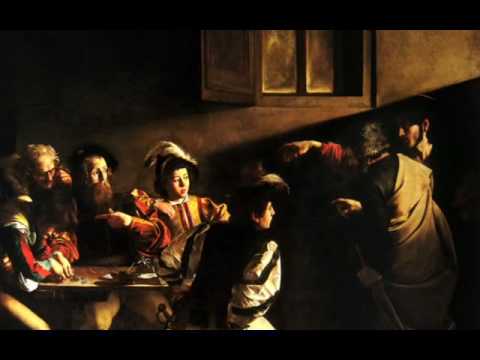7.11: El llamado de Caravaggio a San Mateo
- Page ID
- 103239
La Dra. Beth Harris y el Dr. Steven Zucker brindan una descripción, perspectiva histórica y análisis del Llamamiento de San Mateo de Caravaggio.
Caravaggio, Llamamiento de San Mateo, c. 1599—1600, óleo sobre lienzo, (Capilla Contarelli, San Luigi dei Francesi, Roma).
Un tema favorito para los artistas barrocos fueron momentos en los que uno recorre su vida cotidiana, y luego de repente lo divino entra en esa vida mundana, cotidiana, y todo cambia para siempre. Como hemos visto, los momentos que cambian la vida, como la conversión (piense en San Pablo) o las visiones espirituales (como Santa Teresa) también son populares entre los artistas barrocos.
La historia del Nuevo Testamento, de Jesús llamando a Leví (después Mateo) para ser su discípulo es realmente muy simple, pero Caravaggio la interpreta tan ricamente. Aquí está la historia del evangelio de Marcos:
13 Entonces Jesús volvió a salir a la orilla del lago y enseñó a las multitudes que se reunían a su alrededor.
14 Mientras caminaba, vio a Leví hijo de Alfeo sentado en su caseta de recaudación de impuestos. “Ven, sé mi discípulo”, le dijo Jesús. Entonces Levi se levantó y le siguió.
15 Esa noche Leví invitó a Jesús y a sus discípulos a ser sus invitados a la cena, junto con sus compañeros recaudadores de impuestos y muchos otros pecadores notorios. (Había mucha gente de este tipo entre las multitudes que seguían a Jesús.)
16 Pero cuando algunos de los maestros de derecho religioso que eran fariseos le vieron comer con gente así, dijeron a sus discípulos: “¿Por qué come con tanta basura?”
17 Cuando Jesús escuchó esto, les dijo: “La gente sana no necesita médico, los enfermos sí. He venido a llamar pecadores, no a los que piensan que ya son lo suficientemente buenos”.

Colaboradores
- El llamado de Caravaggio de San Mateo. Autor: Dra. Beth Harris y Dr. Steven Zucker. Proporcionado por: Khan Academy. Ubicado en: https://web.archive.org/web/20140215024035/http://smarthistory.khanacademy.org/caravaggio-matthew.html. Licencia: CC BY-NC-SA: Atribución-NoComercial-CompartirIgual


